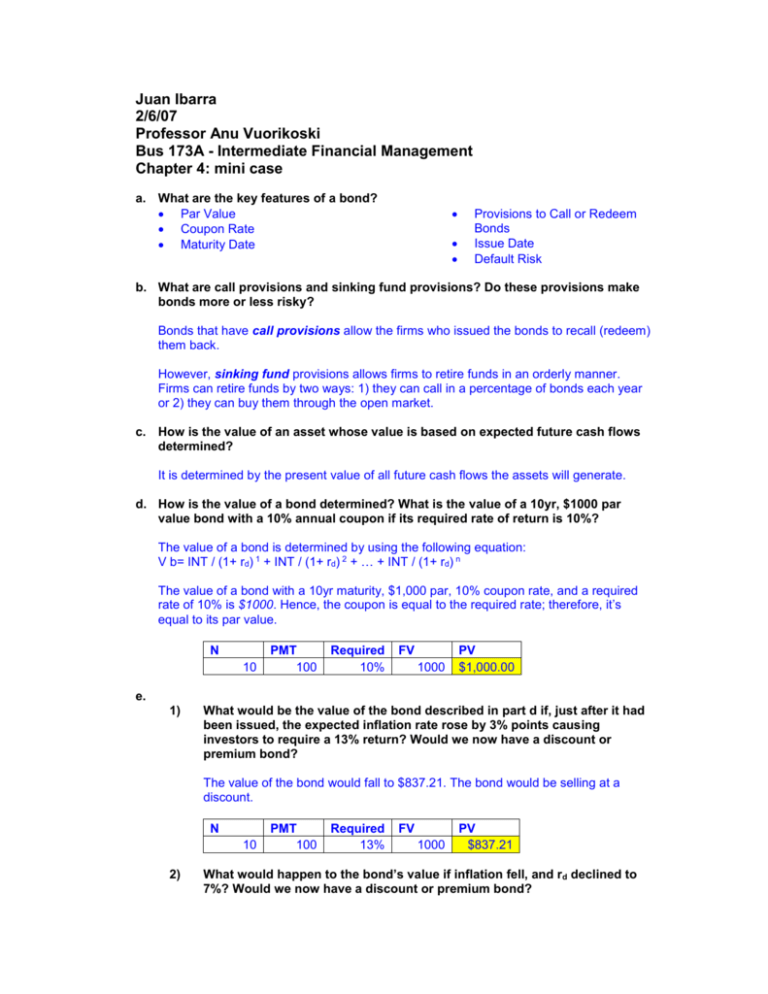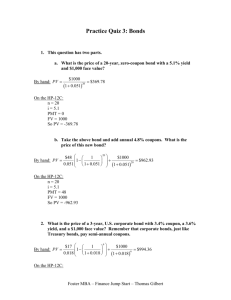Chapter 4 - minicase
advertisement

Juan Ibarra 2/6/07 Professor Anu Vuorikoski Bus 173A - Intermediate Financial Management Chapter 4: mini case a. What are the key features of a bond? Par Value Coupon Rate Maturity Date Provisions to Call or Redeem Bonds Issue Date Default Risk b. What are call provisions and sinking fund provisions? Do these provisions make bonds more or less risky? Bonds that have call provisions allow the firms who issued the bonds to recall (redeem) them back. However, sinking fund provisions allows firms to retire funds in an orderly manner. Firms can retire funds by two ways: 1) they can call in a percentage of bonds each year or 2) they can buy them through the open market. c. How is the value of an asset whose value is based on expected future cash flows determined? It is determined by the present value of all future cash flows the assets will generate. d. How is the value of a bond determined? What is the value of a 10yr, $1000 par value bond with a 10% annual coupon if its required rate of return is 10%? The value of a bond is determined by using the following equation: V b= INT / (1+ rd) 1 + INT / (1+ rd) 2 + … + INT / (1+ rd) n The value of a bond with a 10yr maturity, $1,000 par, 10% coupon rate, and a required rate of 10% is $1000. Hence, the coupon is equal to the required rate; therefore, it’s equal to its par value. N 10 PMT 100 Required 10% FV 1000 PV $1,000.00 e. 1) What would be the value of the bond described in part d if, just after it had been issued, the expected inflation rate rose by 3% points causing investors to require a 13% return? Would we now have a discount or premium bond? The value of the bond would fall to $837.21. The bond would be selling at a discount. N 10 2) PMT 100 Required 13% FV 1000 PV $837.21 What would happen to the bond’s value if inflation fell, and rd declined to 7%? Would we now have a discount or premium bond? The value of the bond would rise to $1,210.71. The bond would be selling at a premium. N 10 3) PMT 100 Required 7% FV 1000 PV $1,210.71 What would happen to the value of the 10 year bond over time if the required rate of return remained at 13%, or if it remained at 7%? The price of the bond will probably fluctuate (if interest rates do not remain constant); however, eventually the price of the bond will approach $1000. f. 1) What is the yield to maturity on a 10 year, 9%, annual coupon, $1000 par value bond that sells for $887.00? The YTM is approximately 10.91% with a value bond of $887 N PMT 10 90 Required 10.911% FV 1000 PV $887.04 That sells for $1,134.20? The YTM is approximately 7.0818% with a value bond of $1,134.20 N PMT 10 90 Required 7.0818% FV 1000 PV $1,134.22 What does the fact that a bond sells at a discount or at a premium tell you about the relationship between rd and the bond’s coupon rate? When rd > coupon rate, then the price of the bond sells at a discount (price tends to fall). When rd < coupon rate, then the price of the bond sells at a premium (price tends to rise). When rd = coupon rate, then the price of the bond sells at par value. 2) What are the total return, the current yield, and the capital gains yield for the discount bond? YTM = Current yield + Capital gains yield Current Yield = Annual Coupon PMT / Current Price CY = $90/$887 = 10.15% Capital Gains Yield = YTM – Current Yield CGY = 10.91% - 10.15% = 0.76% Expected Total Return = YTM = Exp Current YLD + Exp Cap Gains YLD = 10.15% + 0.76% = 10.91% g. What is the interest rate (or price) risk? Which bond has more interest rate risk, an annual payment 1 year bond or 10 year bond? Why? Interest rate risk is the fluctuation of interest rate overtime. A 1yr bond with an annual payment will have less interest rate risk because its price is less sensitive to a change in interest rates compared to a 10yr bond. h. What is reinvestment rate risk? What has more reinvestment rate risk, a 1yr bond or a 10yr bond? Reinvestment rate risk is the risk of an income decline as a result from a reduction in interest rates. Short-term investment have more risk to reinvestment risk because “the fewer the years when the relatively high old interest rate will be earned, and the sooner the funds will have to be reinvested at the new low rate.” (pg 133 from textbook) i. How does the equation for valuing a bond change if semiannual payments are made? You need to divide the coupon and required rate by 2 and multiply the number of years by 2. Find the value of a 10yr, semiannual payment, and 10% coupon bond if nominal rate is 13%. Assuming the par value is $1000, the value of the bond would be $834.72 N PMT 20 j. 50 Required 6.5000% FV 1000 PV $834.72 Suppose you could buy a, for $1000, either a 10%, 10yr, annual payment bond or a 10%, 10yr, semiannual payment bond. They are equally risky. Which would you prefer? N 10 N 20 PMT 100 Required 10.0000% FV PMT Required 5.0000% FV 50 1000 PV $1,000.00 1000 PV $1,000.00 I would prefer the semiannual bond because the number of payments sooner. k. Suppose you could buy a 10yr, 10%, semiannual bond with par value of $1000 is selling for $1135.90, producing a nominal yield to maturity of 8%. However, the bond can be called after 5 years for a price of $1,050. 1) What is the bond’s nominal yield to call (YTC)? The bond’s YTC is 8.4745% N PMT Required 4 100 8.4745% 2) FV 1000 PV $1,049.50 If you bought this bond, do you think you would be more likely to earn the YTM or the YTC? Why? I can’t tell. It depends on the fluctuation of the interest rates from today until the day of maturity. l. Boeing’s bonds were issued with a yield to maturity of 7.5%. Does the YTM represent the promised or expected return on the bond? It represents the expected return on the bond. m. Boeing’s bonds were rated AA by S$P. Would you consider these bonds investment grade or junk bonds? They would be investment grade, since they fall between the investment grades of AAA and BBB of S&P. n. What factors determine a company’s bond rating? The following determine a company’s bond rating: Ratios; mortgage provisions; subordination provisions; guarantee provisions; sinking fund; maturity; stability; regulations; antitrust; overseas operations; product liability; environmental factors; labor unrest; accounting policies. o. If this firm were to default on the bonds, would the company be immediately liquidated? Would the bondholders be assured of receiving all of their promised payments? It depends. If the company cannot be saved, then it must liquidate its assets. However, bondholders are not promised to receive all of their payments. If the company can still be saved, then it can reorganize the firm and continue its existence. The firms here will workout a repayment plan for shareholders.






